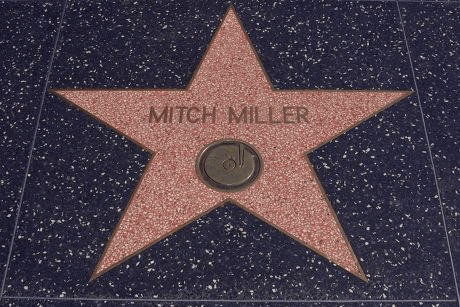Few artists have bridged the gap between classical excellence and mass-market success like Mitch Miller. A trained oboist and English horn player who launched his career in orchestras, Miller went on to shape the sound of American popular music in the 1950s and ’60s. His contributions earned him a star on the Hollywood Walk of Fame, located at 7013 Hollywood Boulevard, in the Recording category, unveiled on February 8, 1960.
From Orchestra Pits to Recording Studios
Born July 4, 1911, in Rochester, New York, Miller began his musical journey as a prodigious oboist, eventually studying at Eastman School of Music and performing with the CBS Symphony Orchestra. In the 1940s, he transitioned into the recording industry, initially with Mercury Records, where he produced hits for artists like Frankie Laine and Patti Page. But it was his tenure as A&R director at Columbia Records (1950–1965) that made him an industry titan.
Architect of the ‘Columbia Sound’
Under Miller’s leadership, Columbia skyrocketed from fourth place to record industry dominance. He produced dozens of hits, launching icons like Doris Day, Tony Bennett, Rosemary Clooney, Johnny Mathis, and Guy Mitchell. Miller was a studio innovator, experimenting with overdubbing, French horns, harpsichords, and choral ensembles to craft a distinctive, polished sound.
Sing Along with Mitch: The Pop Cultural Phenomenon
In 1958, Miller began releasing albums with sing-along choruses. The concept exploded into his NBC TV show Sing Along with Mitch (1961–1966), which featured lyrics on-screen and invited viewers to join in. The show inspired early forms of karaoke and became a cultural staple, drawing hundreds of thousands of tribute letters and massive tune-along participation.
Hollywood Recognition
Miller’s broad influence spanning classical performance, hit record production, and TV entertainment led to his Walk of Fame honor in 1960. His star commemorates his vast contributions to recorded music and his unique role in bridging genres.
Later Career and Controversies
After leaving Columbia in 1965, Miller continued guest-conducting symphony and pops orchestras, including the Boston Pops and LSO. Known for his rigid conducting style and trademark goatee, he was often parodied, but remained respected for musical integrity. Despite his disdain for rock ‘n’ roll and reluctance to embrace it, his innovations profoundly shaped pop music.
A Legacy That Endures
Mitch Miller passed away at age 99 in 2010, leaving a vast musical legacy. He earned a Grammy Lifetime Achievement Award in 2000 and was later inducted into the Rochester Music Hall of Fame. His songs, TV show, and recordings remain emblematic of an era when music was communal and crafted with precision.
Conclusion
Mitch Miller’s story is one of transformation from orchestra stages to record boardrooms to Hollywood sidewalks. His Walk of Fame star is more than a symbol of fame; it’s a recognition of artistic versatility, technical ingenuity, and enduring cultural impact. Next time you pass 7013 Hollywood Blvd, take a moment to appreciate a man who taught America to sing and shaped the soundtracks of generations.



















